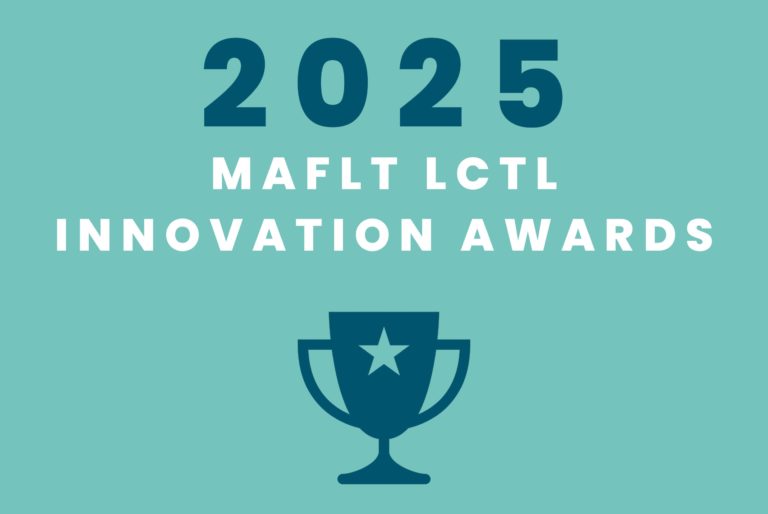The power of real-world texts in LCTL learning
Guest post by Borbala Gaspar, Lecturer of Italian at the University of Arizona
Using real-world texts in the language classroom is not new. We find authentic texts in language textbooks most frequently in the form of advertisements, business cards, screenshots of websites, segments of newspaper articles, or literature. These texts tend to be positioned as supporting materials, in addition to the main lesson parts of foreign language textbooks. At least, this is my personal experience scrolling through foreign language textbooks and working with a handful of Italian textbooks for the last 18 years. Real-world texts are great to have for learners because these texts are created with real-world purposes and are representative of social and cultural contexts. As learners engage with real-world texts, they get to see how social and cultural differences affect the text and are reflected in texts. These texts offer a multicultural and multilingual variety of the studied language and culture. Texts are also multimodal and present a variety of textual features that together contribute to meaning-making. These include linguistic, visual, aural, gestural, and spatial elements that together construct meaning. Yet, these real-world texts do not end up under the spotlight they deserve! To illustrate the practical application of utilizing real-world texts in language instruction, let’s delve into a specific set of activities from the online platform Italian in Wonderland, a collaborative effort between Letizia Maria Bellocchio, Beppe Cavatorta, and myself.
The four activity types
When we use real-world texts, it is important to choose a specific genre for our learners. Teaching students the structure of genre and how it is constructed in the language they are learning is an important skill. The activity set that I would like to share with you today comes from the module titled Mobility, a module in an intermediate first-semester Italian course. Inspired by the pedagogical approach of multiliteracies (Paesani et al., 2016; Paesani & Menke, 2023), learners first complete activities that fall under experiencing. These activities are meant to activate the vocabulary and knowledge learners already know while also presenting new information. For instance, the two screenshots below are part of a series of Instagram posts. Learners are asked a couple of questions related to their transportation practices and then introduced to these Instagram posts about traveling.


The goal here is to understand the posts, translate the meaning if there is an idiomatic expression, be able to tell what they noticed in the screenshot and in the text that accompanies the screenshot (such as hashtags, title, comments), and discuss what is already familiar, new, or surprising for them.
Following this activity, learners are introduced to a series of posters in relation to sustainable traveling, as you can see two examples below.


First, students get familiar with the new vocabulary of traveling, activate the vocabulary they already know, and start learning new vocabulary, for example, by translating these posters. Once the translations are done, we focus on conceptualizing, which refers to the genre. Learners reflect on the color choices, why there is not much text on the poster, why there are some imperative forms used in a poster, why the illustration is simple, etc.
The next activity is the analysis part. During the analysis, they start reflecting on the text choice, idiomatic expressions, structure, and cultural information found in the text. For instance, “Fai andare i tuoi prosciutti” means “Move your thighs,” literally “Move your hams”; or “Non fare il salame, usa la bici,” literally means “Don’t be a sausage, use your bike.” Being a sausage is an idiomatic expression to say: “Don’t be an idiot.” Then they critically reflect on why the author of this poster decided to use these idiomatic expressions. They notice that the audience is the citizens of Parma. At the bottom written in blue, you read, “In Parma we pedal with taste,” this is to say, every single genre we create, we create it with an audience in mind. These posters contain a lot of references to food because this is what Parma is known for and what they are proud of. And if we want our text in a specific genre to be effective, we have to make sure we can connect with the audience.
The students’ work
Finally, in the Applying part of an activity, learners create their own version of the genre, or they could turn one genre into another, keeping in mind the structural and cultural elements that they have learned about specific genres. My students created their posters. In their simple design, they considered adding a recognizable image for their local communities, and a short text, just as they have seen in the Italian posters. In the example below you see the choices that the students make to create a similar connection with the citizens of Tucson, the way the Parma poster did with the citizens of Parma. The poster on the right says: The only true American design of transportation, and it aims to emphasize the American product as one that citizens most likely will proudly choose. The poster on the left has also a simple design with a silhouette of Tucson in the background and the fairly new streetcar design called Sunlink. The motto is: Keep Tucson moving (in movement).

I hope you consider designing your own lessons using real-world text with a genre-based focus, and that you get inspired to use the multiliteracies framework. These two books (Paesani et al., 2015; Paesani & Menke, 2023) were surely a great inspiration for me to create multiliteracies-inspired lessons and activities.
Why do texts matter?
These four types of knowledge processes that the above-mentioned activities are featuring are based on the multiliteracies approach developed by the New London Group (1996, 2000) with the desire to create activities that better prepare learners to become great communicators in a changing world and to help learners recognize the social and cultural differences. As learners experience, conceptualize, analyze, and apply knowledge, they gain new skills in interpretive, interpersonal, and presentational communication. As we discussed above, texts could be, and should be, essential components of beginning LCTL courses because they help analyze various types of discourses, help learners reflect on a variety of ways to make meaning, they also support learners in making connections between language, literature, culture, and society. As learners create those connections, they engage in critical reading practices and help them better determine the legitimacy of information in the era of information overload and mis-/disinformation.
References
Paesani, K. & Menke, M. (2023). Literacies in Language Education: A Guide for Teachers and Teacher Educators. Georgetown Univ. Press.
Paesani, K., Allen, H. W., & Dupuy, B. (2015). A multiliteracies framework for collegiate foreign language teaching. Upper Saddle River, NJ: Pearson Education.


